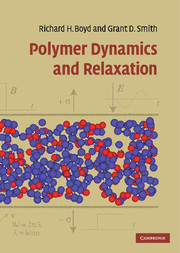Book contents
- Frontmatter
- Contents
- Preface
- Part I Methodology
- 1 Mechanical relaxation
- 2 Dielectric relaxation
- 3 NMR spectroscopy
- 4 Dynamic neutron scattering
- 5 Molecular dynamics (MD) simulations of amorphous polymers
- Part II Amorphous polymers
- Part III Complex systems
- Appendix AI The Rouse model
- Appendix AII Site models for localized relaxation
- Index
- References
1 - Mechanical relaxation
Published online by Cambridge University Press: 10 November 2009
- Frontmatter
- Contents
- Preface
- Part I Methodology
- 1 Mechanical relaxation
- 2 Dielectric relaxation
- 3 NMR spectroscopy
- 4 Dynamic neutron scattering
- 5 Molecular dynamics (MD) simulations of amorphous polymers
- Part II Amorphous polymers
- Part III Complex systems
- Appendix AI The Rouse model
- Appendix AII Site models for localized relaxation
- Index
- References
Summary
Regimes of behavior
Amorphous polymers tend to behave in an elastic manner at low temperature in the glassy state. The strain at break is usually small (a few percent), they can deform quickly, hold their length at constant load, and recover completely when unloaded (Figure 1.2). The material is elastic. In the vicinity of the glass transition temperature when the length of the specimen is held constant the stress decays with time (stress relaxation). Under constant load (creep), in addition to the instantaneous deformation characteristic of the glass, the sample deforms in a time dependent fashion and when released from constant load recovers nearly completely and in a time dependent manner (retarded elasticity) (Figure 1.2). Such a material is called anelastic. At higher temperature, in addition to the instantaneous and retarded elasticity a non-recoverable strain appears in the creep experiment due to viscous flow (Figure 1.3). The material is viscoelastic.
There is a considerable advantage in being able to describe and summarize the above behavior in terms of a simple model. For example, it would be impractical to perform every type of mechanical test on a sample. Rather it would be much better to perform enough measurements to characterize the material and then predict the results of other tests from a model. Continuum linear elasticity theory is soundly based on the application of classical mechanics to the deformation of solids.
- Type
- Chapter
- Information
- Polymer Dynamics and Relaxation , pp. 3 - 26Publisher: Cambridge University PressPrint publication year: 2007

